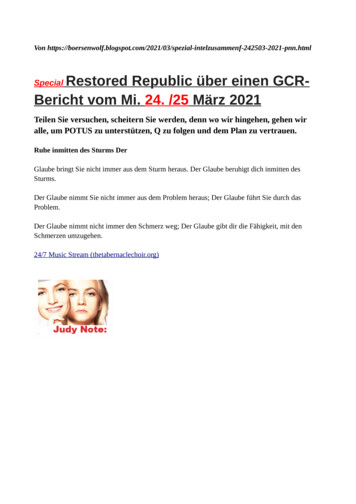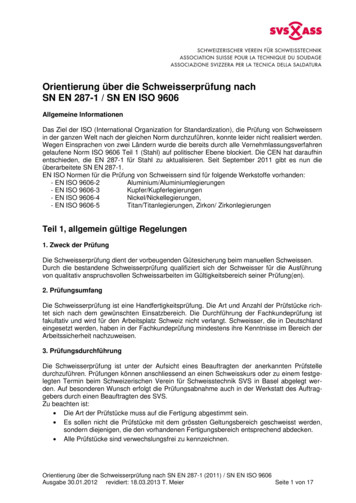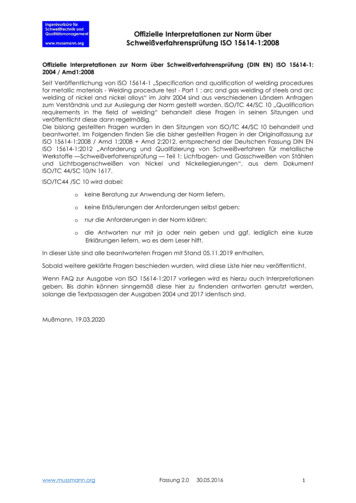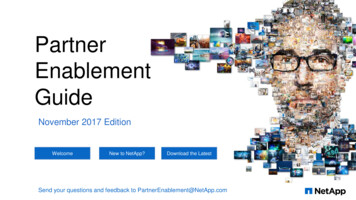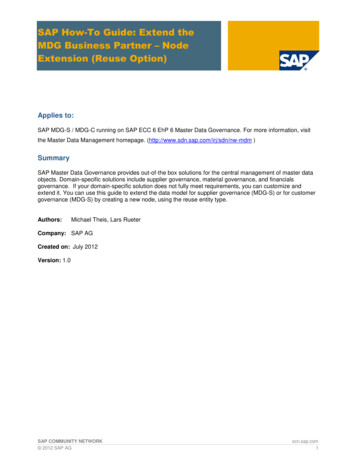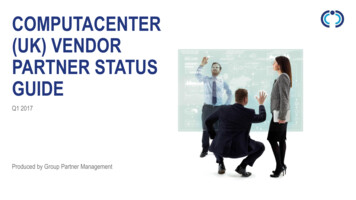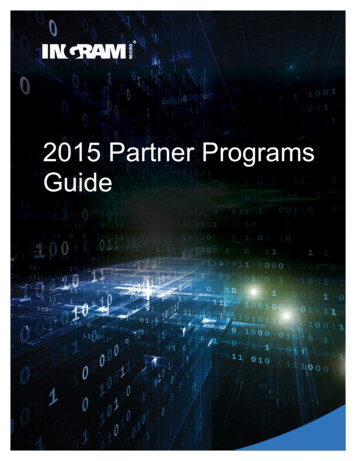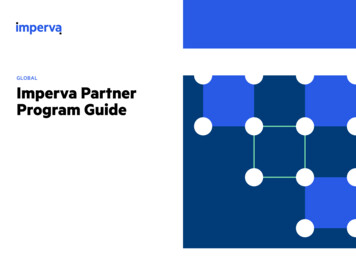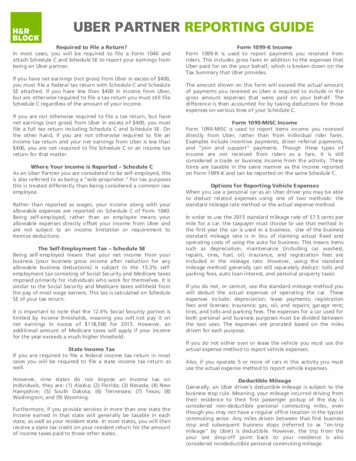
Transcription
UBER PARTNER REPORTING GUIDERequired to File a Return?In most cases, you will be required to file a Form 1040 andattach Schedule C and Schedule SE to report your earnings frombeing an Uber partner.If you have net earnings (not gross) from Uber in excess of 400,you must file a federal tax return with Schedule C and ScheduleSE attached. If you have less than 400 in income from Uber,but are otherwise required to file a tax return you must still fileSchedule C regardless of the amount of your income.If you are not otherwise required to file a tax return, but havenet earnings (not gross) from Uber in excess of 400, you mustfile a full tax return including Schedule C and Schedule SE. Onthe other hand, if you are not otherwise required to file anincome tax return and your net earnings from Uber is less than 400, you are not required to file Schedule C or an income taxreturn for that matter.Where Your Income is Reported – Schedule CAs an Uber Partner you are considered to be self-employed, thisis also referred to as being a “sole-proprietor.” For tax purposesthis is treated differently than being considered a common lawemployee.Rather than reported as wages, your income along with yourallowable expenses are reported on Schedule C of Form 1040.Being self-employed, rather than an employee means yourallowable expenses directly offset your income from Uber andare not subject to an income limitation or requirement toitemize deductions.The Self-Employment Tax – Schedule SEBeing self-employed means that your net income from yourbusiness (your business gross income after reduction for anyallowable business deductions) is subject to the 15.3% selfemployment tax consisting of Social Security and Medicare taxesimposed primarily for individuals who work for themselves. It issimilar to the Social Security and Medicare taxes withheld fromthe pay of most wage earners. This tax is calculated on ScheduleSE of your tax return.It is important to note that the 12.4% Social Security portion islimited by income thresholds, meaning you will not pay it onnet earnings in excess of 118,500 for 2015. However, anadditional amount of Medicare taxes will apply if your incomefor the year exceeds a much higher threshold.State Income TaxIf you are required to file a federal income tax return in mostcases you will be required to file a state income tax return aswell.However, nine states do not impose an income tax onindividuals, they are: (1) Alaska; (2) Florida; (3) Nevada; (4) NewHampshire; (5) South Dakota; (6) Tennessee; (7) Texas; (8)Washington; and (9) Wyoming.Furthermore, if you provide services in more than one state theincome earned in that state will generally be taxable in eachstate, as well as your resident state. In most states, you will thenreceive a state tax credit on your resident return for the amountof income taxes paid to those other states.Form 1099-K IncomeForm 1099-K is used to report payments you received fromriders. This includes gross fares in addition to the expenses thatUber paid for on the your behalf, which is broken down on theTax Summary that Uber provides.The amount shown on this form will exceed the actual amountof payments you received as Uber is required to include in thegross amount expenses that were paid on your behalf. Thedifference is then accounted for by taking deductions for thoseexpenses on various lines of your Schedule C.Form 1099-MISC IncomeForm 1099-MISC is used to report items income you receiveddirectly from Uber, rather than from individual rider fares.Examples include incentive payments, driver referral payments,and “join and support” payments. Though these types ofincome are not received from riders as a fare, it is stillconsidered a trade or business income from the activity. Theseitems are taxable in the same manner as the income reportedon Form 1099-K and can be reported on the same Schedule C.Options for Reporting Vehicle ExpensesWhen you use a personal car as an Uber driver you may be ableto deduct related expenses using one of two methods : thestandard mileage rate method or the actual expense method.In order to use the 2015 standard mileage rate of 57.5 cents permile for a car, the taxpayer must choose to use that method inthe first year the car is used in a business. Use of the businessstandard mileage rate is in lieu of claiming actual fixed andoperating costs of using the auto for business. This means itemssuch as depreciation, maintenance (including car washes),repairs, tires, fuel, oil, insurance, and registration fees areincluded in the mileage rate. However, using the standardmileage method generally can still separately deduct: tolls andparking fees, auto loan interest, and personal property taxes.If you do not, or cannot, use the standard mileage method youwill deduct the actual expenses of operating the car. Theseexpenses include: depreciation; lease payments; registrationfees and licenses; insurance; gas, oil, and repairs; garage rent;tires; and tolls and parking fees. The expenses for a car used forboth personal and business purposes must be divided betweenthe two uses. The expenses are prorated based on the milesdriven for each purpose.If you do not either own or lease the vehicle you must use theactual expense method to report vehicle expenses.Also, if you operate 5 or more of cars in this activity you mustuse the actual expense method to report vehicle expenses.Deductible MileageGenerally, an Uber driver's deductible mileage is subject to thebusiness stop rule. Meaning, your mileage incurred driving fromtheir residence to their first passenger pickup of the day isconsidered non-deductible personal commuting miles, eventhough you may not have a regular office location in the typicalcommuting sense. Any miles driven between that first businessstop and subsequent business stops (referred to as "on-tripmileage" by Uber) is deductible. However, the trip from theyour last drop-off point back to your residence is alsoconsidered nondeductible personal commuting mileage.
UBER PARTNER REPORTING GUIDEExpenses Subject to AllocationWhen you use your personal auto to drive for Uber certainexpenses must be allocated between business use and personaluse. The amount deductible is based on a percentage generallycalculated by dividing the total deductible miles for the activityby the total miles the vehicle was driven for all purposes duringthe year. Only the business portion of the following items ofexpense paid by a driver, or collected by Uber on the driver’sbehalf, can be deducted. Uber Fuel Card Fees Property TaxesInterest on Auto LoansLease Payments*Fuel, Oil, and Tires*Repairs and Maintenance (including car washes)*Insurance*Registration and Tags*Parking*Expenses that are covered by the standard mileage rate, andtherefore not deductible in addition to the amount deductedbased on that rate.Fully-Deductible ExpensesThe following items of expense paid by a driver, or collected byUber on the driver’s behalf, are fully deductible as a businessexpense. The Uber Fee Uber Provided Device SubscriptionsTolls Incurred During On-Trip MileageSales Tax CollectedBlack Car Fund FeesCity FeesAirport FeesSplit Fare FeesSafe Rides FeesRefreshments provided solely to riders. Items you consumeare in most cases nondeductible.Estimated Tax PaymentsIndividuals driving for Uber may be required to make estimatedquarterly tax payments equal to 25% of your “required annualpayment” to avoid penalties for underpayment. For most, therequired annual payment individuals is the lower of 90% of thetax shown on your return or 100% of the tax shown on lastyear’s return.Most people who receive the bulk of their income in the formof wages satisfy these payment requirements through the taxwithheld by their employer from their paycheck. Otherwise theycan make additional payments via IRS Form 1040-ES or the IRS’online tax payment system.As Uber issues Form 1099-K it is important that you make surethat you are meeting these quarterly tax payment obligationsthroughout the year as the form provides the IRS with abreakdown of the payments you receive on a month-to-monthbasis.Options for Filing Your ReturnH&R Block has three options for filing a tax return reportingbusiness income received as an Uber partner. File In an Office. H&R Block has a network of over 80,000highly-trained tax professionals in over 10,000 locationsready to handle your income tax needs.File Using H&R Block Software or Online. Both H&RBlock’s software and online products are specificallytailored to get you the maximum refund that you deserve.All three methods are backed by a Maximum RefundGuarantee. For returns prepared in an office a Peace of Mind extended service plan can be purchased. For 40 you receiveAudit Assistance PLUS Audit Representation (a 250 value) andyour return will be protected for 3 years. H&R Block will pay upto 6,000 in additional taxes owed due to our error.The H&R Block Refund BonusIf you file your return using H&R Block software or through H&RBlock Online you can put some – or all – of your refund to thepurchase of e-gift cards with select retailers, and as bonus H&RBlock will add up to 10% to the amount on the gift card.
UBER PARTNER REPORTING GUIDEFrequently Asked QuestionsAm I required to file a tax return?In most cases, you will be required to file a Form 1040 andattach Schedule C and Schedule SE to report your earnings frombeing an Uber partner.If you have net earnings (not gross) from Uber in excess of 400,you must file a federal tax return with Schedule C and ScheduleSE attached. If you have less than 400 in income from Uber,but are otherwise required to file a tax return you must still fileSchedule C regardless of the amount of your income.If you are not otherwise required to file a tax return, but youhave net earnings (not gross) from Uber in excess of 400, youmust file a full tax return including Schedule C and Schedule SE.On the other hand, if you are not otherwise required to file anincome tax return and their income from self-employment is lessthan 400 they are not required to file Schedule C or an incometax return for that matter.By being “otherwise required to file a return” we mean that thetaxpayer would be required to file an income tax return if theydid not actually have any income from self-employmentreportable on Schedule C. For example, a taxpayer with otherforms of income in excess of the annual filing thresholds fortheir filing status would be considered to be otherwise requiredto file a tax return.The following chart outlines the rules discussed above.UberEarnings 0 to 399 400 0 to 399 400 OtherwiseReq. to FileNoNoYesYesForm1040NoYesYesYesSch. CSch. SEN/AYesYesYesN/AYesNoYesHow will I be taxed?In most situations, taxpayers driving for Uber (or other similarride-sharing services) will be doing so with a profit motive. Assuch, the income received will be considered trade or businessincome reportable on Schedule C subject to self-employmenttax. This schedule is filed, and any associated taxes paid, withyour personal income tax return (Form 1040).What is the “self-employment tax”?Self-employment tax is a tax consisting of Social Security andMedicare taxes primarily for individuals who work forthemselves. It is similar to the Social Security and Medicare taxeswithheld from the pay of most wage earners.You must pay self-employment tax and file Schedule SE (Form1040) your net earnings from self-employment (excludingchurch employee income) were 400 or more.Am I subject to state income tax?If you are required to file a federal income tax return in mostcases you will be required to file a state tax return as well.However, nine states do not impose an income tax onindividuals, they are: (1) Alaska; (2) Florida; (3) Nevada; (4) NewHampshire*; (5) South Dakota; (6) Tennessee; (7) Texas; (8)Washington**; and (9) Wyoming.*New Hampshire does impose a business profits tax, which abased off of the net profit from the activity.**Washington does impose business and occupation tax basedoff of the gross receipts from the activity, rather than net profit.What if a partner drives in multiple states?If you provide Uber services in more than one state your incomeearned in that state will generally be taxable in each state, withthe total amount earned in all states taxable in-whole in yourresident state.Depending on the state, you will then likely receive anonrefundable state tax credit on your resident state incometax return for the amount of income taxes paid to those otherstates.Am I subject to local/city income taxes?In addition to federal and state income taxes you may besubject to local income taxes. Approximately 5,000 cities,counties or other similar jurisdiction impose local income taxeson income earned in their area or on their residents who earnincome outside of the area. It is important that you check withyour local government’s website to determine if you are in aarea that imposes such a tax.Are there special city taxes that are imposed specificallyon for-hire drivers?Certain cities and airports will impose an additional tax ondrivers granting them the right to operate in the city. Thesetaxes are generally deductible on Schedule C.Am I subject to sales tax?Only 9 states will require you to collect sales tax from riders,which then must be remitted to the state. They are: (1) Georgia;(2) Hawaii; (3) New Jersey*; (4) New Mexico; (5) Ohio; (6) RhodeIsland; (7) South Dakota; (8) West Virginia**; and (9) Wyoming.Under federal law, these taxes can only be imposed on ridestaking place solely within the particular state. For example, ifyou pick up a rider in Georgia and drop them off in Florida, orvice versa, you will not be required to collect sales tax from thatrider.*New Jersey only imposes their sales tax on “black car” limos.**West Virginia only imposes sales tax on drivers who are notcertified by the West Virginia Public Service Commission.Do I need an Employer Identification Number (EIN)?Most Uber partners will not need to obtain an EIN, but mayelect to do so.
UBER PARTNER REPORTING GUIDEFrequently Asked QuestionsHow will I be taxed if I form an LLC?An LLC is a business entity formed under the state lawprovisions of an LLC statute. By default, an LLC formed withonly one member is disregarded for tax purposes. This meansthat the activities of the LLC are reported on the member’sindividual tax return (Schedule C) in the same manner as theywould had the LLC not existed.An LLC formed by two-or-more members is by default taxed as apartnership. Both single-member and multi-member LLCs canelect to be taxed as corporations.What does a partner’s Form 1099-K report?Form 1099-K is used to report payments received from riders.This includes gross fares in addition to the expenses that Uberpaid for on your behalf, which is broken down on the Uberprovided Tax Summary. Generally, the total amount shown onthe Form 1099-K should be reported as gross receipts onSchedule C of your tax return.What does a partner’s Form 1099-K report?Form 1099-K is used to report payments received from riders.This includes gross fares in addition to the expenses that Uberpaid for on your behalf, which is broken down on the Uberprovided Tax Summary. Generally, the total amount shown onthe Form 1099-K should be reported as gross receipts onSchedule C of your tax return.Why does the amount on my Form 1099-K not match theamount I actually received?This total amount will exceed the actual amount of paymentsfrom Uber the taxpayer received as Uber is required to includein the taxpayer’s gross amount on their Form 1099-K expensesthat were paid on the taxpayer’s behalf. The difference is thenaccounted for by taking deductions for those amounts paid foron the taxpayer’s behalf on various lines of Schedule C.What does a partner’s Form 1099-MISC report?Form 1099-MISC is used to report items of non-employeecompensation received directly from Uber, rather than fromindividual rider fares. Examples include incentive payments,driver referral payments, and “join and support” payments.Though these types of income are not received from riders as afare, it is still considered a trade or business income from theactivity. These items are taxable in the same manner as theincome reported on Form 1099-K as gross receipts on line 1 ofSchedule C.What mileage is deductible?Generally, an Uber driver’s deductible mileage is subject to thebusiness stop rule. Meaning, their mileage incurred driving fromtheir residence to their first passenger pickup of the day isconsidered non-deductible personal commuting miles, eventhough they may not have a regular office location in thetypical commuting sense. Any miles driven between that firstbusiness stop and subsequent business stops (referred to as “ontrip mileage” by Uber) is deductible. However, the trip from thetaxpayer’s last drop-off point back to his residence is alsoconsidered nondeductible personal commuting mileage.What are my options for deducting vehicle expenses?A taxpayer who uses a personal car as an Uber driver may beable to deduct related expenses using one of two methods: thestandard mileage rate or the actual expense method.If a taxpayer wants to use the standard mileage rate for a carthey own, the taxpayer must choose to use that method in thefirst year the car is used in a business. Then in later years, thedriver can choose to use either the standard mileage rate oractual expenses. If the taxpayer wants to use the standardmileage rate for a car they lease, it must be used for the entirelease period.Use of the business standard mileage rate is in lieu of claimingactual fixed and operating costs of using the auto for business .This means items such as depreciation, maintenance, repairs,tires, fuel, oil, insurance, and registration fees are included inthe mileage rate. However, a taxpayer using the standardmileage method generally can still separately deduct: tolls andparking fees, auto loan interest, and personal property taxes.If the taxpayer does not use the standard mileage rate, thedriver deducts the actual expenses of operating the car. Theseexpenses include: depreciation; lease payments; registrationfees and licenses; insurance; gas, oil, and repairs; garage rent;tires; and tolls and parking fees. The expenses for a car used forboth personal and business purposes must be divided betweenthe two uses. The expenses are prorated based on the milesdriven for each purpose.What special rules apply to fleet operators?If you operate a fleet of cars driving for Uber you will limited tousing the actual expense method if you use five or morevehicles during the same year in your business. in other words, ataxpayer can use the standard mileage rate in computing thedeductible costs of operating up to four automobiles that areused simultaneously for business purposes.How do I treat my toll expenses?Tolls you pay while driving passengers for Uber are deductible .This includes tolls that you paid out-of-pocket, and tolls thatUber paid on your behalf and included in the amount shown onyour Form 1099-K. Furthermore, tolls are deductible whetheryou use the standard mileage method or the actual expensemethod to calculate your deduction.Can I deduct my toll payment device convenience fees?Fees associated with electronic toll devices are deductible.However, you must allocate the total expense between businessand personal use. Only the portion attributable to business useis deductible. The portion attributable to personal use is anondeductible personal expense.Such expenses are deductible whether you use the actualexpense method or standard mileage method.Can I deduct car washes?If you use the actual expense method to report your vehicleexpenses the amount of car washes multiplied by the businessuse percentage of the vehicle is deductible.If you use the standard mileage method to deduct your vehicleexpenses, the cost of a car wash is not deductible. This isbecause car washes are considered to be maintenance of thevehi
When you use a personal car as an Uber driver you may be able to deduct related expenses using one of two methods: the standard mileage rate method or the actual expense method. In order to use the 2015 standard mileage rate of 57.5 cents per mile for a car

